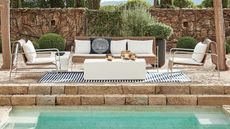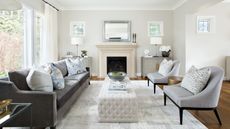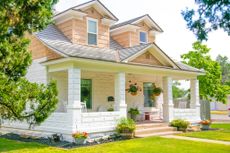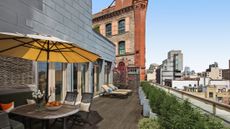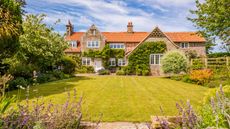America's smallest house is just one of many spite houses, built to confound the neighbors
The Spite House is America's smallest house at just 7ft wide. Curiously, it's not its size but its fascinating history that actually makes it – and others like it – really interesting

脾气暴躁的房屋是引人入胜的建筑物,不是主要用于职业,而是混淆邻居或惹恼当地人。其中包括美国最小的房子,弗吉尼亚州旧城区亚历山大皇后街的Spite House。
This historic home is just 7ft wide and around 25ft deep, and 325 sq ft in total across its two stories. Painted bright blue, it's a tourist attraction that Alexandria is rightly proud of. And, as you might hope, it comes with a history as fascinating as its proportions. Read on to find out more.
See more:America's most expensive house: Don't miss the chance to tour this awesome home
A post shared by Visit Alexandria VA (@visitalexva)
A photo posted by on
这座恶意之家由约翰·霍伦斯伯里(John Hollensbury)于1830年建造。但是他并没有盖房子来为一个不断发展的家庭赢得更多空间...相反,他建造了它以阻止房屋之间跑步的小巷,以便粗心大意的马车驾驶员,他们的车轮已经损坏了他的外观墙壁房屋将不再可以访问。他还被聚集在小巷里的嘈杂的人们所困扰。
Hollensbury didn't work too hard on the structure of The Spite House – if anything he merely blocked the alley at either end, using the brick walls of the existing houses to provide the side walls. The gouges made by the wagon wheels were never repaired, and add character of the living room walls, something that's appreciated by the owners, who renovated it around 10 years ago.
The Spite House in 1924, below
A post shared by Goodies Frozen Custard &Treats (@mmmgoodies)
A photo posted by on
So what's it like inside? Amazingly, it packs a lot of punch for a home that bears the title of America's smallest house.
As you go through the front door, you enter the living room, with its charming exposed ceiling beams, painted brick walls and mantel, creating a faux fireplace the sofa and armchair group around. Beyond the living space, there is a narrow staircase to the second floor.
There is a cupboard under the stairs with space for a microwave oven on top; on the opposite wall of this narrowest of galley kitchens is a kitchen counter, which houses a range, a kitchen sink, a refrigerator and freezer. Next to the cupboard under the stairs is a wooden kitchen table, pushed against the wall. Space is tight but there's room for two to dine comfortably, three or four at a push. Clever use is made of vertical space, with high shelves for display of antique artefacts.
Beyond the kitchen is a pretty patio garden, accessed through French doors.
See more:Small kitchen ideas– to turn your compact kitchen into a smart, organised space
A post shared by Kimberly A. Akers (@nashvillegirl88)
A photo posted by on
Upstairs, the hallway is lined with storage cupboards. In fact, clever storage is a running theme upstairs, with cupboard space even found for a stacked washer-dryer. The bedroom at the front of The Spite House has just enough space for a double bed, pushed against the wall. At the back of the house is a bathroom with a handsome roll top, freestanding bath.
The Skinny House – another tiny spite house
A post shared by TU DINH | UTAH REALTOR (@realtortudinh)
A photo posted by on
A close runner up for the title of America's smallest house is The Skinny House in Boston (above). Unsurprisingly, it's also a spite house. This 10ft wide property on Hull Street in Boston went on sale back in 2017 for an amazing $895,000. The house, with its four stories, does boast more space – 1,166 square feet to be exact – and has a back yard and roof terrace.
According to local legend – and it's just the most interesting one that circulates – the house stands on land that was left to two brothers by their father. While one was away serving in the American Civil War, the other took advantage, building himself a large home on the plot, certain that there was no room for a house to be built next to it. The soldier is said to have returned from war and built the narrow house out of spite, blocking his brother's views and sunlight.
Which is the most famous spite house?
Arguably, the most famous of the spite houses is the Richardson Spite House that used to sit on Lexington Avenue in New York. This four story, 5ft wide house was built in 1882, but demolished in 1915.
Its owner, Joseph Richardson, built it after the owner of the plot next door, a Hyman Sarner, tried – and failed – to buy the plot for just $1,000. Richardson asked for $5,000 but was refused. So, he built the apartment building that, although tiny, contained eight suites he could lease out profitably.

My first job was writing a DIY column for a magazine for the over 50s (which seemed a long way off back then). I then moved to a DIY magazine as deputy ed, then freelanced my way around the homes departments of most women's magazines on the market before working onYour Homeand家庭圈子magazines as homes editor. From there, I went to理想的家magazine as associate editor, then launched4Homesmagazine for Channel 4, then the Channel 44Homeswebsite before going back to freelancing and running a social media business (you can see where I had kids from the freelancing gaps!). I was tempted back to the world of big business by the chance to work with the great team atRealhomes.com, where I was Global Editor-in-Chief for two and a half years, taking it from a small website to a global entity. I've now handed the reins of the website to our American managing editor, while I take on a new challenge as Editor-in-Chief of Homes & Gardens.
-
-
 Nordstrom Anniversary Sale: shop our edit of the best 5 early access home décor deals
Nordstrom Anniversary Sale: shop our edit of the best 5 early access home décor dealsDive right into the Nordstrom Anniversary sale and score these sensational selections.
By Brittany Romano •
-
 Best outdoor rugs 2021: stylish options for your backyard
Best outdoor rugs 2021: stylish options for your backyardThe best outdoor rugs for zoning an outside space and adding style and comfort to the backyard; we've rounded up the top neutrals, colors and patterns
By Amy Lockwood •
-
 5 design tips to steal from this elegant yet kid-proof Vancouver family home
5 design tips to steal from this elegant yet kid-proof Vancouver family homeThis modern-traditional decor scheme may look pristine, but it's ready for anything family life can throw at it
By Ailis Brennan •
-
 Inside Max Azria's ultra-opulent Los Angeles estate – listed for $85 million
Inside Max Azria's ultra-opulent Los Angeles estate – listed for $85 millionThe Holmby Hills kingdom is one of the grandest homes built by the celebrated architect Paul Williams
By Megan Slack •
-
 工匠的房子风格——它是什么,以及如何课时ieve it
工匠的房子风格——它是什么,以及如何课时ieve itEverything you need to know about Craftsman style homes, inside and out
By Timothy Latterner •
-
 Isaac Slade, the lead singer of The Fray, lists his beautifully designed Colorado home for $2.95 million
Isaac Slade, the lead singer of The Fray, lists his beautifully designed Colorado home for $2.95 millionVictorian property in Denver's West Highland boasts a maze of chandeliers, chintz wallpaper, and freestanding tubs
By Megan Slack •
-
 An apartment overlooking London's Covent Garden piazza gets a history-astute update
An apartment overlooking London's Covent Garden piazza gets a history-astute updateWith 400 years of culture-packed history at its feet, the renovation of this London home draws on it all
By Ailis Brennan •
-
 David Bowie’s New York apartment is a stylish haven with views across SoHo – for $16.8 million
David Bowie’s New York apartment is a stylish haven with views across SoHo – for $16.8 millionThe former chocolate factory is now an art-filled maze – and has found a buyer after less than one month on the market
By Megan Slack •
-
 Mid century modern homes – the ultimate design guide
Mid century modern homes – the ultimate design guide您需要了解的有关世纪中叶现代房屋的所有信息
By Timothy Latterner •
-
 This English coastal cottage has a beautiful interior that marries traditional and modern details
This English coastal cottage has a beautiful interior that marries traditional and modern detailsA holiday cottage in Northumberland, once a hayloft and coach house, combines modern country chic with coastal touches, resulting in a much-loved family escape
By Vivienne Ayers •


